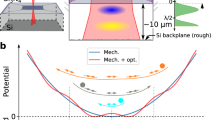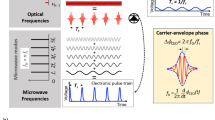Abstract
Frequency combs have high time–frequency accuracy, which makes them useful for applications in precision spectroscopy, ultra-sensitive detection and atomic clocks. Traditional methods of creating frequency combs hinge on material nonlinearities, which are often weak. These methods require high power densities to surpass their initiation thresholds, subsequently limiting their potential use. Here we demonstrate a nonlinear coupling process that efficiently generates magnonic frequency combs by exploiting exceptional points in a coupled system of two different magnon modes. Our approach is a simple and optimal path to produce magnonic frequency combs at low pump power with excellent tunability of exceptional points.
This is a preview of subscription content, access via your institution
Access options
Access Nature and 54 other Nature Portfolio journals
Get Nature+, our best-value online-access subscription
$29.99 / 30 days
cancel any time
Subscribe to this journal
Receive 12 print issues and online access
$209.00 per year
only $17.42 per issue
Buy this article
- Purchase on Springer Link
- Instant access to full article PDF
Prices may be subject to local taxes which are calculated during checkout




Similar content being viewed by others
Data availability
The data that support the findings of this study are available from Zenodo at https://doi.org/10.5281/zenodo.10807440 (ref. 48). Source data are provided with this paper.
Code availability
The MATLAB codes for drawing figures in this work are available from the corresponding authors upon reasonable request.
References
Hänsch, T. W. Nobel lecture: passion for precision. Rev. Mod. Phys. 78, 1297–1309 (2006).
Fortier, T. & Baumann, E. 20 years of developments in optical frequency comb technology and applications. Commun. Phys. 2, 153 (2019).
Cundiff, S. T. & Ye, J. Colloquium: femtosecond optical frequency combs. Rev. Mod. Phys. 75, 325–342 (2003).
Udem, T., Holzwarth, R. & Hänsch, T. W. Optical frequency metrology. Nature 416, 233–237 (2002).
Del’Haye, P. et al. Optical frequency comb generation from a monolithic microresonator. Nature 450, 1214–1217 (2007).
Ludlow, A. D., Boyd, M. M., Ye, J., Peik, E. & Schmidt, P. O. Optical atomic clocks. Rev. Mod. Phys. 87, 637–701 (2015).
Lezius, M. et al. Space-borne frequency comb metrology. Optica 3, 1381–1387 (2016).
Diddams, S. A., Hollberg, L. & Mbele, V. Molecular fingerprinting with the resolved modes of a femtosecond laser frequency comb. Nature 445, 627–630 (2007).
Thorpe, M. J., Moll, K. D., Jones, R. J., Safdi, B. & Ye, J. Broadband cavity ringdown spectroscopy for sensitive and rapid molecular detection. Science 311, 1595–1599 (2006).
Picqué, N. & Hänsch, T. W. Frequency comb spectroscopy. Nat. Photonics 13, 146–157 (2019).
Coddington, I., Swann, W. C. & Newbury, N. R. Coherent multiheterodyne spectroscopy using stabilized optical frequency combs. Phys. Rev. Lett. 100, 013902 (2008).
Cao, L., Qi, D., Peng, R., Wang, M. & Schmelcher, P. Phononic frequency combs through nonlinear resonances. Phys. Rev. Lett. 112, 075505 (2014).
Ganesan, A., Do, C. & Seshia, A. Phononic frequency comb via intrinsic three-wave mixing. Phys. Rev. Lett. 118, 033903 (2017).
Wu, S. et al. Hybridized frequency combs in multimode cavity electromechanical system. Phys. Rev. Lett. 128, 153901 (2022).
Wang, Z. et al. Magnonic frequency comb through nonlinear magnon-skyrmion scattering. Phys. Rev. Lett. 127, 037202 (2021).
Zhao, C. et al. Dissipative-coupling-induced transparency and high-order sidebands with Kerr nonlinearity in a cavity-magnonics system. Phys. Rev. Appl. 18, 044074 (2022).
Hula, T. et al. Spin-wave frequency combs. Appl. Phys. Lett. 121, 112404 (2022).
Rao, J. W. et al. Unveiling a pump-induced magnon mode via its strong interaction with Walker modes. Phys. Rev. Lett. 130, 046705 (2023).
Xiong, H. Magnonic frequency combs based on the resonantly enhanced magnetostrictive effect. Fundam. Res. 3, 8–14 (2023).
Hache, T. et al. Control of four-magnon scattering by pure spin current in a magnonic waveguide. Phys. Rev. Appl. 20, 014062 (2023).
Zhang, C. et al. Control of magnon–polariton hybridization with a microwave pump. Phys. Rev. Appl. 20, 024074 (2023).
Kittel, C. Physical theory of ferromagnetic domains. Rev. Mod. Phys. 21, 541–583 (1949).
Morrish, A. H. The Physical Principles of Magnetism (Wiley, 2001).
Dembowski, C. et al. Experimental observation of the topological structure of exceptional points. Phys. Rev. Lett. 86, 787–790 (2001).
Miri, M.-A. & Alù, A. Exceptional points in optics and photonics. Science 363, eaar7709 (2019).
Ergoktas, M. S. et al. Topological engineering of terahertz light using electrically tunable exceptional point singularities. Science 376, 184–188 (2022).
Kononchuk, R., Cai, J., Ellis, F., Thevamaran, R. & Kottos, T. Exceptional-point-based accelerometers with enhanced signal-to-noise ratio. Nature 607, 697–702 (2022).
Lai, Y.-H., Lu, Y.-K., Suh, M.-G., Yuan, Z. & Vahala, K. Observation of the exceptional-point-enhanced Sagnac effect. Nature 576, 65–69 (2019).
Wiersig, J. Enhancing the sensitivity of frequency and energy splitting detection by using exceptional points: application to microcavity sensors for single-particle detection. Phys. Rev. Lett. 112, 203901 (2014).
Hodaei, H. et al. Enhanced sensitivity at higher-order exceptional points. Nature 548, 187–191 (2017).
Zhang, X., Ding, K., Zhou, X., Xu, J. & Jin, D. Experimental observation of an exceptional surface in synthetic dimensions with magnon polaritons. Phys. Rev. Lett. 123, 237202 (2019).
Peng, B. et al. Parity–time-symmetric whispering-gallery microcavities. Nat. Phys. 10, 394–398 (2014).
Chen, W., Kaya Özdemir, Ş., Zhao, G., Wiersig, J. & Yang, L. Exceptional points enhance sensing in an optical microcavity. Nature 548, 192–196 (2017).
Pick, A., Lin, Z., Jin, W. & Rodriguez, A. W. Enhanced nonlinear frequency conversion and Purcell enhancement at exceptional points. Phys. Rev. B 96, 224303 (2017).
Lin, Z., Pick, A., Lončar, M. & Rodriguez, A. W. Enhanced spontaneous emission at third-order Dirac exceptional points in inverse-designed photonic crystals. Phys. Rev. Lett. 117, 107402 (2016).
Lü, X.-Y., Jing, H., Ma, J.-Y. & Wu, Y. \({{{\mathcal{P}}}}{{{\mathcal{T}}}}\)-symmetry-breaking chaos in optomechanics. Phys. Rev. Lett. 114, 253601 (2015).
Bu, J.-T. et al. Enhancement of quantum heat engine by encircling a Liouvillian exceptional point. Phys. Rev. Lett. 130, 110402 (2023).
Jing, H. et al. Pt-symmetric phonon laser. Phys. Rev. Lett. 113, 053604 (2014).
Doloca, N. R., Meiners-Hagen, K., Wedde, M., Pollinger, F. & Abou-Zeid, A. Absolute distance measurement system using a femtosecond laser as a modulator. Meas. Sci. Technol. 21, 115302 (2010).
Juan, Y.-S. & Lin, F.-Y. Demonstration of arbitrary channel selection utilizing a pulse-injected semiconductor laser with a phase-locked loop. Opt. Express 19, 1057–1064 (2011).
Fukushima, S., Silva, C., Muramoto, Y. & Seeds, A. J. Optoelectronic millimeter-wave synthesis using an optical frequency comb generator, optically injection locked lasers, and a unitraveling-carrier photodiode. J. Light. Technol. 21, 3043–3051 (2003).
Sasaki, R., Nii, Y. & Onose, Y. Magnetization control by angular momentum transfer from surface acoustic wave to ferromagnetic spin moments. Nat. Commun. 12, 2599 (2021).
Lodahl, P. et al. Chiral quantum optics. Nature 541, 473–480 (2017).
Yu, T., Luo, Z. & Bauer, G. E. Chirality as generalized spin–orbit interaction in spintronics. Phys. Rep. 1009, 1–115 (2023).
Yu, T. et al. Magnon accumulation in chirally coupled magnets. Phys. Rev. Lett. 124, 107202 (2020).
Özdemir, Ş. K., Rotter, S., Nori, F. & Yang, L. Parity–time symmetry and exceptional points in photonics. Nat. Mater. 18, 783–798 (2019).
Else, D. V., Bauer, B. & Nayak, C. Floquet time crystals. Phys. Rev. Lett. 117, 090402 (2016).
Wang, C. Data of ‘Enhancement of Magnonic Frequency Combs by Exceptional Points’. Zenodo https://doi.org/10.5281/zenodo.10807440 (2024).
Acknowledgements
This work has been funded by the Strategic Priority Research Program of the Chinese Academy of Sciences (CAS; Grant No. XDB0580000 to B.M.Y.), the National Natural Science Foundation of China (NSFC; Grant No. 12204306 to J.W.R. and Grant No. 12122413 to B.M.Y.), the Youth Innovation Promotion Association of CAS (Grant No. 2020247 to B.M.Y.), the Science and Technology Commission of Shanghai Municipality (STCSM; Grant Nos. 21JC1406200, 23JC1404100 and 22JC1403300 to B.M.Y.), the Shanghai Institute of Technical Physics (SITP) Independent Foundation (B.M.Y.), the Shanghai Pujiang Program (Grant No. 22PJ1410700 to J.W.R.), the Qilu Young Scholar Program of Shandong University (J.W.R.), the NSFC (Grant Nos. 12227901 and 11991063 to W.L.), the National Key R&D Program of China (Grant No. 2022YFA1405200 to Y.P.W.), the NSFC (Grant Nos. 92265202 and 12174329 to Y.P.W. and Grant Nos. 0214012051 and 12374109 to T.Y.), the National Key R&D Program of China (Grant No. 2023YFA1406600 to T.Y.), startup grants from Huazhong University of Science and Technology (Grant Nos. 3004012185 and 3004012198 to T.Y.), the National Key R&D Program of China (Grant No. 2022YFA1404600 to L.X.S.) and the Strategic Priority Research Program of CAS (Grant No. XDB43010200 to L.X.S.).
Author information
Authors and Affiliations
Contributions
J.W.R. and B.M.Y. conceived this study and designed the experimental set-up. C.Y.W., J.W.R. and B.M.Y. performed the measurements and data analysis. J.W.R. built the theoretical model and wrote the supplementary document. J.W.R., B.M.Y., C.Y.W., T.Y., Y.P.W., L.X.S., Z.J.C., K.X.Z. and W.L. together contributed to the writing of the paper. W.L. supervised this work.
Corresponding authors
Ethics declarations
Competing interests
The authors declare no competing interests.
Peer review
Peer review information
Nature Physics thanks Peng Yan and the other, anonymous, reviewer(s) for their contribution to the peer review of this work.
Additional information
Publisher’s note Springer Nature remains neutral with regard to jurisdictional claims in published maps and institutional affiliations.
Supplementary information
Supplementary Information
Supplementary Figs. 1–10, Discussion and Tables 1 and 2.
Supplementary Video 1
Right-handed polarization of the microwave field at the cross centre, when the phase difference between the two pump signals was −90°.
Supplementary Video 2
Linear polarization of the microwave field at the cross centre, when the phase difference between the two pump signals was 0°.
Supplementary Video 3
Left-handed polarization of the microwave field at the cross centre, when the phase difference between the two pump signals was 90°.
Source data
Source Data Fig. 2
Measured transmission, coupling strength and calculation results at different polarizations.
Source Data Fig. 4
Measured radiation spectra and theoretical calculations of MFCs.
Rights and permissions
Springer Nature or its licensor (e.g. a society or other partner) holds exclusive rights to this article under a publishing agreement with the author(s) or other rightsholder(s); author self-archiving of the accepted manuscript version of this article is solely governed by the terms of such publishing agreement and applicable law.
About this article
Cite this article
Wang, C., Rao, J., Chen, Z. et al. Enhancement of magnonic frequency combs by exceptional points. Nat. Phys. (2024). https://doi.org/10.1038/s41567-024-02478-0
Received:
Accepted:
Published:
DOI: https://doi.org/10.1038/s41567-024-02478-0



